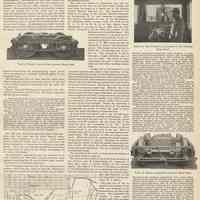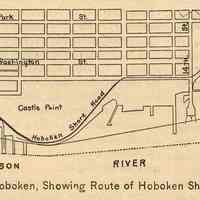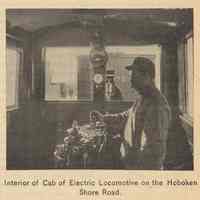Collections Item Detail
Article re Hoboken Shore Railroad: New Electric Freight Locomotive; in The Railroad Gazette, Vol. XXX, No. 2, Jan. 14, 1898.
2011.005.0122
2011.005
Lukacs, Claire
Gift
Museum Collections. Gift of a friend of the Museum.
1898 - 1898
Date(s) Created: 1898 Date(s): 1898
Notes: archives 2011.005.0122 The Railroad Gazette, Vol. XXX, No. 2, January 14, 1898, pg 25. New Electric Freight Locomotive. On Tuesday of last week the Hoboken Railroad, Warehouse & Steamship Connecting Co placed in regular service on the Hoboken Shore Road a 28% ton electric locomotive, built by the General Electric Co. The road is about two miles in length, running from the docks of the North German Lloyd Steamship Co. in Hoboken north along the River Walk, over a private right of way between Fourteenth and Seventeenth streets, thence to the Erie station in Weehawken, as shown by the accompanying map. The road was opened in September last, and the switching of the cars for the past three months has been done by means of a repair car of the Hudson County Electric Railroad Co. The locomotive was built at the shops of the General Electric Company, at Schenectady, N.Y., and resembles in appearance the electric locomotive in use on the Manufacturers' Railroad, which connects with the track of the N. Y., N. H. & H. R. R. at New Haven, Conn, (illustrated in our issue of Jan. 8, 1896), and the well-known locomotives at the Belt Line tunnel [photo illustration left: Truck of Electric Locomotive—Hoboken Shore Road.] of the Baltimore & Ohio at Baltimore. This recent locomotive is mounted on two four-wheel trucks (shown in the accompanying figures), each axle carrying a G. E. 2000 motor, giving the locomotive a total of 540 rated horse-power. The weight on the drivers is 57 200 lbs.; the drawbar pull is 10,000 lbs. The locomotive is driven through a single reduction gear of very low ratio. The speed is correspondingly low, and is rated at eight miles an hour when hauling a heavy load. At each end of the locomotive is an automatic coupler and a small railed platform for the brakeman. The cab is made of iron throughout and resembles a double steam locomotive cab, with a sloping tender shield at each end. Drop windows are placed on the four sides of the cab, affording an unobstructed view in all directions to the motorman. This feature is well illustrated in the accompanying engravings. Beneath one of the shields is the compressed air tank and the equalizing air tank; beneath the other, eight resistances, two sand boxes and the engineer's tool box. At one end of the cab is placed a controller of the series parallel type known as the L 2, arranged to drive the motors either four in series or each two in series multiple. Beside the controller is the air-brake handle and the two valves of the sanding arrangement by means of which the sand is blown under the wheels by means of compressed air. In front of the motorman's cab is an air-brake gage and above it an ammeter reading to 500 amperes. Fastened to the roof of the cab is an "L " automatic circuit breaker set at 500 amperes. On the other side of the controller from the motorman is an "M" circuit breaker and an automatic governor switch for the air pump, placed at the other end of the cab. This is a cylinder pump driven by a 3-H. P. iron-clad bipolar slow-speed motor. The operation of this air pump is automatic. When the air in the tanks is at normal pressure the governor switch is opened. Blowing the whistle, applying the brakes or using the sander causes the pressure to fall; this closes the switch automatically and starts the motor and pump. The cab is lighted by five incandescent lamps. The current for the road is taken from the station of the Hudson Electric Light Co. The Hudson Shore road is one of the sub-companies of the Hudson Land & Improvement Co. organized 52 years ago, under a special charter, by the Stevens family. Mr. Edwin A. Stevens is President and Robert L. and Richard Stevens are respectively First and Second Vice-Presidents of the new road; the General Manager and Treasurer is Palmer Campbell and the Secretary W. A. Macey. [illustration left: Map of Hoboken, Showing Route of Hoboken Shore Road.] The trial trip of the locomotive on Tuesday of last week was witnessed by representatives of many railroads. The locomotive was coupled to eieht loaded freight cars with an aggregate dead weight of 295-5/8 tons, and it handled this train with ease. It was then coupled to a number of passenger coaches, and the party made the journey over the line from Hoboken to Weehawken and return. At the luncheon which followed two interesting addresses were made. Mr. F. Le Bau, General Freight Agent of the West Shore, pointed out the use and ad-; vantage of such lines as the Hoboken Shore road in facilitating the transportation of merchandise directly from the steamships. Mr. W. J. Clark, General Manager of the Railway Department of the General Electric Co., spoke as follows; "Ten years ago, the development of three things made electric street railroads practicable and profitable. These were the under-running trolley, the carbon brush and the modern method of motor suspension. The development of three other things now renders the general application of electricity to standard railroads both possible and probable. These are the safe breaking of heavy currents, high voltage for their transmission and methods for their application to almost any load on any portion of a line. Other features are being developed that will seriously affect the result; not the least of these i» the Sprague system of multiple and unit control, increasing the flexibility of the already most elastic of all transportation agents, and while the economy of electricity has already been thoroughly demonstrated in performing the same service as by steam or animal traction—at least so far as passenger service is con- [photo illustration: Interior of Cab of Electric Locomotive on the Hoboken Shore Road.] cerned—something beyond the mere question of economy must now be considered, namely, the accomplishment by electrical methods of what would be entirely impossible with steam. The first steam railroad man within my range of acquaintance to fully grasp this idea is Mr. John Lundie, Consulting Engineer of the Illinois Central, who has set a pace on acceleration that would not have been dreamed of two years ago; and the schedule which he has mapped out for the contemplated electrical equipment of the suburban lines of his company involves a rate up to 40 miles per hour in 20 seconds. That this is practical has already been demonstrated. (See Railroad Gazette for Oct. 1 and 15, 1897.) The foregoing refers only to passenger service. "In another direction even greater changes may be prophesied which will come from the adoption of electricity in standard railroading, viz., the lengthening of freight trains and the consequent reduction in transportation wages. The advantages of electricity will have so thoroughly demonstrated themselves in the directions suggested that instead of main steam lines with electric feeders, in 10 years it will be a question of electrically operated main lines with steam feeders through the sparsely settled districts, and a more extended system of suburban and interurban electric roads in densely populated districts also feeding the main lines. "The electrical engineer has much to learn from the steam railroad man and must constantly rely upon him for suggestions as to the best methods of making practical applications of electricity. The American transportation man and the American electrical engineer should go on hand in hand, continuing to lead the world as they now do in all transportation problems. The Amer can engineer has won conquests abroad as well as at home; not the least is the solution of the problem of electrical equipment for the Central London Underground Railway, the most important of this character that has as yet been accomplished. The American engineering plans wrere selected on account of their merit in [photo illustration: Truck of Electric Locomotive—Hoboken Shore Road.] the face of the severest competition from every European electrical manufacturing company, and no greater tribute can be paid to American engineering methods than to state that 80 per cent, of all the railroad apparatus used in Europe is designed in America, so that the American engineer stands to-day head and shoulders above those of any other country. With the encouragement of the co-operation of American railroad men, he is bound to revolutionize the entire method of transportation within a comparatively short space of time, so that American railroad methods will then, as now, be in advance of those existing anywhere else on the face of the earth [end] Status: OK Status By: dw Status Date: 2011-06-01



![detail left photo: Truck of Electric Locomotive [side view]](https://d3f1jyudfg58oi.cloudfront.net/11047/image/1f820a00-fb1e-11ed-a641-b3912f9925a9-uFi0VsQ.tn.jpg)


![detail right photo: Truck of Electric Locomotive [end view]](https://d3f1jyudfg58oi.cloudfront.net/11047/image/23162d40-fb1e-11ed-a641-b3912f9925a9-uFi0X4r.tn.jpg)